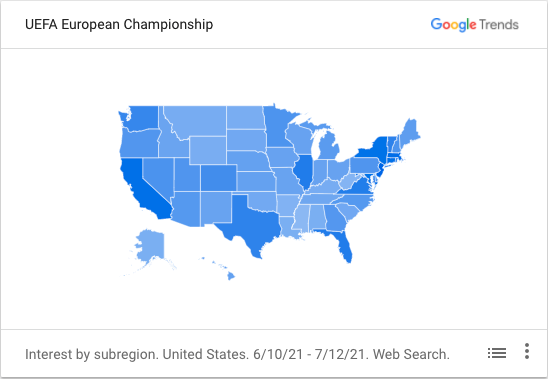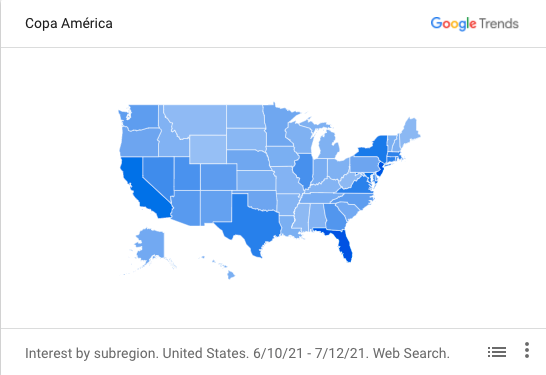After a year delay thanks to the pandemic, the Euros and Copa America were held and, boy, did it feel great to watch high-level international competitions again.
Before both competitions are too far in our rearview mirror, we wanted to recap the events and tell a story of interest – both in terms of searching and watching. Using Google Trends and TV ratings insights, we’re able to give both tournaments a proper send-off through these lenses:
- Search interest by day in each tournaments
- Overall search volume
- Top U.S. markets for each tournament by search volume
- Total event TV viewership
- Event viewership relative to other sporting events
Search interest in the Euros and Copa America
One way to gauge interest in something – in this case the Euros and Copa America – is by consulting Google Trends to understand the volume of searches for a specific topic during a specified period of time. We use Google Trends often as a way to keep our finger on the pulse of what’s trending in the sports and entertainment world.
As you can see in the animated chart below, with Google’s help, we took a look at U.S. consumer interest in both tournaments from mid-June through mid-July. What did we learn? Like with most month-long competitions, there are ebbs and flows in interest based on when games are played, who is playing, and what happens in those games.
Search volume around each competition’s final was highest, which is an obvious insight, but you’ll see the volume high-water mark around the Copa America final was sustained longer. One of the best players of all-time winning a trophy will certainly have the Internet buzzing. Other search volume peaks in Copa America centered around Argentina and Messi, like an outrageous free kick on July 3rd that moved him one goal behind Pelé for the South American international goal-scoring record.
Peaks in search volume for the Euros centered around days like June 23rd, on which Group Stage standings were finalized in the “Group of Death,” featuring France, Germany, and Portugal. Other high levels of search volume were centered around the English team, who, on June 29th and July 3rd, secured victories to advance to the next round of the tournament.
Top Markets for the Euros
Drilling down locally to understand what markets searched for Euros-related topics most helps paint a more detailed story. In the graphic below you can see the states with highest search volume. I encourage you to click the image to visit the site so you can see metro areas and cities, as well.
Insight: Italy vs. England was searched over 6 million times in the U.S. in the 48 hours surrounding the final

Does anything surprise you or stand out? To me, this confirms what we’ve already known. States like New York, New Jersey, Virginia / D.C., Florida, Illinois, Texas, California are soccer hotbeds and residents in those states did a lot of searching around the Euros.
Below is a list of the ten metro areas where residents conducted the most Euros-related searches. Among the list are several markets that consistently feature atop soccer TV ratings, as well as our GESM Soccer Market rankings.
Metro areas that searched about the European Championship the most:
- Miami-Ft. Lauderdale FL
- San Francisco-Oakland-San Jose CA
- Washington DC (Hagerstown MD)
- New York NY
- Boston MA-Manchester NH
- Yuma AZ-El Centro CA
- Charlottesville VA
- San Diego CA
- Los Angeles CA
- Monterey-Salinas CA
Top Markets for Copa America
Just like the Euros, diving deeper into Copa America search volume by state or city presents an interesting story. The same states again top the list, but when you look at the top ten metro areas, the list features many more Hispanic-heavy markets. For a tournament featuring South American teams, this makes sense.
Insight: Argentina vs. Brazil was searched over 1 million times in the U.S. in the 48 hours surrounding the final; Messi was searched over 500 thousand times

Metro areas that searched about Copa America the most:
- Miami-Ft. Lauderdale FL
- West Palm Beach-Ft. Pierce FL
- New York NY
- Yuma AZ-El Centro CA
- Harlingen-Weslaco-Brownsville-McAllen TX
- Laredo TX
- Washington DC (Hagerstown MD)
- Houston TX
- Los Angeles CA
- El Paso TX
Euros and Copa America TV ratings
Google searches only tell a piece of the story. A search can result from one of two things: (1) a lack of knowledge and understanding or (2) wanting quick access to answers and insights, i.e. scores and schedules. What a search result doesn’t do is show action. That’s where television ratings help tell a more complete story.
How many people watched?
The Euro 2020 final was the most-watched Euro match ever on ESPN/ABC. An average of 6.5 million viewers tuned in with the peak audience – 8.2 million – coming during the kicks from the mark. Add the 2.9 million average from Univision to the English-language number and a total of 9.4 million watched the final. The English-language per game average during the tournament was 1.4 million viewers.
The Copa America final between Argentina and Brazil was seen by 3.5 million on Univision networks, up 30% from the 2019 final broadcast by Telemundo and down 43% from the Copa Centenario final on Univision in 2016. Average viewership for the English-language broadcast on FOX Sports 1 was 1.8 million, making the total viewing audience for the final 5.3 million viewers.
How do the numbers compare to other U.S. sports?
Context always helps sell the importance of ratings, so below is a chart comparing select sporting events from July 2021 – a month filled with activities that run the sports gamut.
Comparing biennial or quadrennial single-game finals to a series of games like the NBA Finals or NHL Stanley Cup isn’t like-for-like. However, you can’t help but notice viewership for the Euro 2020 final more than doubled – almost tripled – the audience in the most-watched game of the Stanley Cup. Now, you can argue the Stanley Cup only featured one U.S. team and that likely had a slight impact on ratings. You can also argue the NHL has more regional interest than nationwide appeal. Both are likely true, but the Stanley Cup has only averaged more than the 2021 Copa America final three times in the past 15 seasons.
Again, enter these ratings comparison discussions at your own risk because you can cherry pick ratings to fit most narratives. The reality is the soccer-viewing audience continues to show signs of growth as we approach the 2022 FIFA World Cup, 2023 FIFA Women’s World Cup, 2024 Euros, 2024 Copa America, and one event to blow them all out of the water – the 2026 FIFA World Cup in North America.
Categories: Infographics, Just For Fun, Research, Uncategorized
